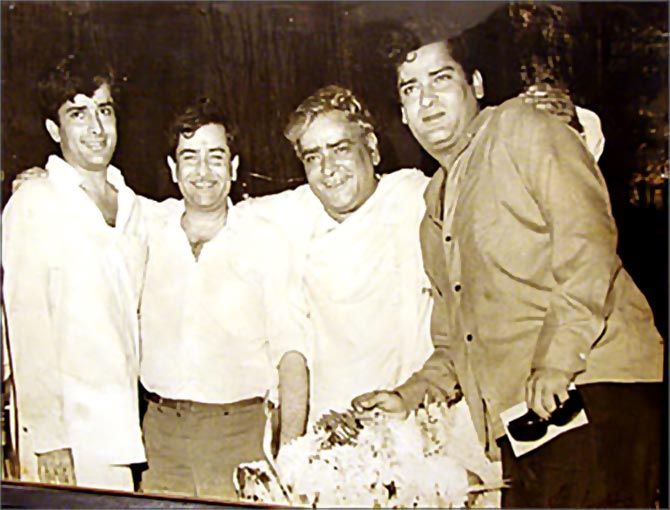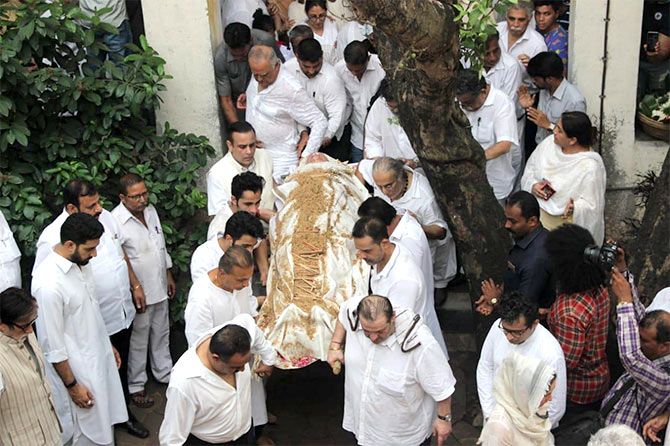R K Studios is not just another piece of real estate; it is part of India's movie history.
Arundhati Dasgupta reports.

Two burly cops walk into a small room hemmed in by an assortment of chairs and tables, their swagger sucking out all the space from its already limited confines.
On the brightly painted walls of the room, photographs of the Kapoor family hang alongside images and idols of gods and goddesses.
A large framed certificate from a fan club deeming Raj Kapoor's movie, Bobby (1973), best film hangs precariously a few inches away from a photograph of the three beaming Kapoor brothers -- Raj, Shammi and Shashi -- with their father, Prithviraj Kapoor.
In the tiny room, a wiry middle-aged man sits under a large garlanded photograph of Raj Kapoor. He gets up in a hurry to greet the two men who, without preamble, ask, "Kay (what)? Are you bringing the god home this time?"
The men are here to discuss the upcoming Ganapati festival, a tradition that Raj Kapoor started in 1952. This could be the last year of celebrations though given the Kapoor family's announcement that the studio is up for sale.
The frazzled man drops his face into his hands and shakes his head vigorously. "Not you, too, sahib," he says, as the cops break into a cackle.
Ever since Rishi Kapoor announced that he was going to let go of the studio that his father built, albeit "chhati pe pathar rakhkar" (with a heavy heart), the phones have been buzzing without respite, says the man who has been fending off queries from everyone -- from the media to local scrap dealers and the handful of people who still work in the studio.

For the local community, the studio is inseparable from the annual Ganpati festival that takes place every August-September. Serpentine queues outside its gates and the raucous processions that marked immersion day are vivid memories.
Everyone recalls being a part of the crowd that lined up for a glimpse of the Kapoors and their heroines dancing down the streets.
It was only after the R K Studio Ganpati had made its way out of Chembur did it feel as if the festival was finally over, says a shopkeeper who was a regular in the crowd.
R K Studios was a city landmark long before Chembur, the Mumbai suburb it is located in, became habitable. It drew tourists and locals to its gates for the grand movies that were shot inside and for the stories around the man who built it.
But it stands still today, quietly in the shade of tall trees and under the close watch of its caretakers. No cameras line up against its walls, and its lavish sets are long forgotten.
Large portions of the two-acre studio, destroyed by a fire in September 2017, have been cordoned off.
The grass on the lawns has worn, exposing vast brown patches on the grounds that once played host to so many magnificent parties.

Everyone remembers the Holi parties, when food was abundant and bhang flowed like water. Actors vied for an invitation and film journals of the day were filled with accounts of romantic alliances made or broken at the annual jamboree.
Centre-spreads of actresses being dunked into a tub of coloured water, placed somewhere at the centre of the studio's sprawling grounds, helped sell many a magazine.
The studio was also the venue for lavish Punjabi weddings. All of Raj Kapoor's children were married here as were his granddaughters, Karishma (Randhir Kapoor's daughter) and Riddhima (Rishi Kapoor's daughter).
From the extensive communal parties that these weddings were to fiercely guarded affairs fenced off by bouncers, the studio has stood witness to it all.
News of the sale has naturally led to an outpouring of anguish and a sense of loss at the destruction of yet another piece of cultural history. But for those living in the studio's vicinity, their lives influenced and touched by stardust, the grief is personal.

Just outside the studio, under the shadow of its iconic logo that immortalises the Raj Kapoor-Nargis love affair, sits a paanwala whose shop has seen better days. He is exhausted answering the queries of passersby.
Too much drama, he mumbles, assuming the air of one who has seen it all. But he drops his nonchalance to ask, "What have you heard? Are they going to evict us?"
Most of the shops are nothing more than tin sheds on pavements, built on land whose ownership is as ambiguous as the fate that awaits the studio.
Many have changed hands several times over. The original owners having been vacuumed into the cavernous world of Bollywood or driven out by the city's rapacious builders.
Rauf Bungdawala, a swashbuckling young man in a crisp white shirt and neatly combed hair who seems to know everyone around, says he has known no other life but that of a studio assistant at RK.
"It is our jaan (life). How can they sell this?" he asks. Bungdawala's entire family is associated with the film industry, he says proudly.
"Everyone knows us in R K." He is distressed and aghast at how the family can let go of its legacy.
With his hand on his heart, he says, "I hope this does not happen. I can give my life for the studio."
From movie-makers and politicians to old associates of Raj Kapoor, the news has thrown everyone down an emotional spiral.
Many point to the success Mehboob Studio, founded in 1954 by director-producer Mehboob Khan, has made of itself -- it now hosts popular music festivals, literary carnivals and such.
Look at how the other branch of the family has kept the legacy of Prithviraj Kapoor alive through Prithvi Theatre, says Rohini Bhowmick, an entrepreneur who married into a Chembur family.
Surely if theatre can help keep a place alive, movies and the booming television industry should too, say producers who have used the premises in recent years.

One young producer, who does not want to named, says that the studio has been in a state of disrepair for years. When he hired the stage that has since burnt down, paying close to Rs 3 million to Rs 3.5 million a month, he claims he had to use his own money to clean up the place.
The fire was the final straw. It demolished everything.
The famous dresses that Dimple Kapadia wore for Bobby are probably lying in a garbage dump somewhere, says an old associate of the studio.
Fortunately, the Pune-headquartered National Film Archive of India acquired all 23 original prints of films made under the R K banner.
NFAI Director Prakash Magdum says, "I reached out after the fire and Randhir Kapoor came to inspect our facilities. Luckily, he was convinced of our capabilities and generously allowed us to become a home for such iconic films."
The studio, the man who created it and the suburb were inextricably linked.
All of Raj Kapoor's favourite haunts are now part of Chembur lore. One such place, suddenly back in the spotlight since the news of sale, is a dingy hole-in-the-wall called Gupta Bhelpuri.
Gregory Dante, who bought the place from its earlier owners, says, "We grew up on these streets, I saw them (the Kapoors) all come here. They would eat everything -- from chaat and pani-puri to whatever was on the menu." He says he feels lucky to be able to keep a piece of the great man's legacy alive.
Mouleshri Vyas, who first moved to Chembur as a student at the Tata Institute of Social Sciences in 1987, remembers bumping into the man at Gupta Bhelpuri.
"It was a humid mid-monsoon evening and the skies suddenly opened up. We were four of us in search of chaat and the place was highly recommended," says Vyas, now a faculty member at TISS.
"As we trooped in, drenched, we did a double take when we saw Raj Kapoor comfortably settled on a bench." He welcomed them in and asked the proprietor-waiter to hand them a towel to dry themselves.
Raj Kapoor was a popular neighbour. His cottage, a short walk from the studio, is next to the TISS campus.
Old students talk about the times they went carol singing to his house. Raj Kapoor had a special preference for Silent Night and that was sung many times over. And he always had a feast ready for them and would entertain them personally.
A real estate broker who specialises in 'premium properties only' says that emotions are obviously going to run high on such a place. But he understands the Kapoors' desire to sell.
"Tomorrow, there will be no one to take care of the property but everyone will fight for a piece of that land," he says.

But R K Studios is not just another piece of real estate; it is part of the city's history, points out Ashok Kaul, who managed the studio between 1982 and 1996.
Dapper and punctual, Kaul, a former army major who is widely acknowledged as Raj Kapoor's right-hand man, speaks slowly and diplomatically. "It is a sad day; it was sad even when the place was engulfed in flames," he says.
Kaul first met Kapoor as a young officer in Uri. "I was in my quarters one day when someone knocked at the door. I was preoccupied and it took a while to register that the pink-cheeked man who had walked in was Raj Kapoor."
The year was 1975, two years after Bobby had turned his and the studio's fortunes around.
Raj Kapoor wanted to visit an area close to the border with Pakistan and that required special permission from the army.
Kaul drove him to the place and a friendship struck up in the course of the drive blossomed into a deep relationship.
"His love was unconditional and he kept trying to persuade me to come work with him, until one day I did just that," says Kaul.
R K Studios' journey began in September 1950 with Raj Kapoor and a loyal band of friends, technicians and associates performing a pooja on the land that had been bought two years earlier.
This was during the shooting of Awara. By the time the walls went up, the movie was nearing completion.
A final scene, the famous dream sequence that set the template for many such scenes in Hindi movies, had to be shot.
Raj Kapoor wanted it done in the studio. And so he did, inside the four walls of a studio that still had no roof.
With that began a glorious chapter for the showman and his studio that seems to be finally drawing to a close.











